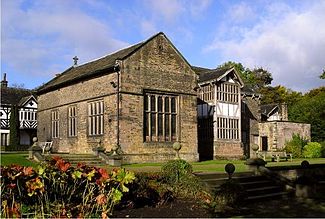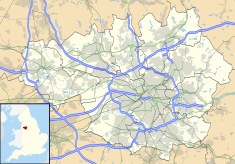Smithills Hall
| Smithills Hall | |||||||||||||||||||||||||||||||
|---|---|---|---|---|---|---|---|---|---|---|---|---|---|---|---|---|---|---|---|---|---|---|---|---|---|---|---|---|---|---|---|

Smithills Hall Chapel and east range.
|
|||||||||||||||||||||||||||||||
|
|||||||||||||||||||||||||||||||
Smithills Hall is a Grade I listed manor house, and a scheduled monument in Smithills, Bolton, Greater Manchester, England. It stands on the slopes of the West Pennine Moors above Bolton at a height of 500 feet, three miles north west of the town centre. It occupies a defensive site near the Astley and Raveden Brooks. One of the oldest manor houses in the north west of England, its oldest parts, including the great hall, date from the 15th century and it has been since been altered and extended particularly the west part. Parts of it were moated. The property is owned by Bolton Metropolitan Borough Council and open to the public.
The name Smithills derives from the Old English smeþe meaning smooth and hyll, a hill and was recorded as Smythell in 1322. Early medieval records about the hall began in 1335 when William Radcliffe acquired the manor from the Hultons who held it from the Knights Hospitaller. On Radcliffe's death in 1369 it passed to his son and heir Sir Ralph Radcliffe, High Sheriff of Lancashire for 1384–1387 and twice MP for Lancashire. The Radciffes lived there until 1485, when the male line failed and Smithills Hall passed to the Bartons, wealthy sheep farmers who lived there for nearly 200 years.
In 1659 the hall and estate passed by marriage to the Belasyse family. In 1722 the Byroms of Manchester bought the manor and kept it until 1801 when the hall and estate were acquired by the Ainsworths, who made their fortune as the owners of bleachworks at Barrow Bridge. Around 1875 Richard Henry Ainsworth employed architect George Devey to extend and modernise the hall. In 1938 the Ainsworths sold the hall to Bolton Corporation. Parts of it became a residential home and day centre that closed in the 1990s.
...
Wikipedia

